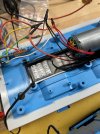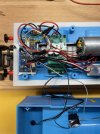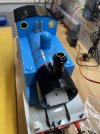Diesel2000
Registered
I recently purchased the 91401 Bachmann Thomas loco and 44968 Bachmann/soundtraxx sound decoder. My daughter has become a huge Thomas fan and this loco has become her favorite possession. The decoder and speaker install was about as easy as it gets. The decoder, however, as others have noted is not great functionally. Any time it loses power over a plastic frog it starts to stutter like its receiving a programming signal and you have to set the throttle to 0 to regain control. This was pretty annoying. The decoder does not have a port for a current keeper like typical Soundtraxx Tsunami decoders. The Thomas engine only has pickup through the 4 driving wheels.
My solution to this problem was to install a Massoth L driving decoder with power caps and use the Thomas decoder just for the sound. I replaced the original selector switch with the switch that came with the power caps connected to track power input and the Thomas decoder so that I could turn off that decoder while programming the Massoth L and so that it could be run without any sound if desired.
The power caps fit nicely in the space above the motor block and under where the Thomas decoder is designed to screw down. I mounted the Massoth L just to the rear of that. There was plenty of space to execute this. Finally I drilled out the smoke stack and installed an 18V LGB smoke unit. This was the main reason I picked the Massoth L over the M decoder because it has a higher current output to drive a smoke unit. The smoker was secured with some epoxy where it joins the boiler.
The whole thing went pretty well. My intention was to install a resistor on the motor terminals on the Thomas decoder to simulate load, but when I connected it all up there was no driving chuff sound, only the function sounds worked. I reached out to Soundtraxx support (who got back to me within an hour) and they said their decoder chuff depends on BEMF and to try turning that off by setting CV217=0. And that worked! I left the resistor in place as its not causing any issues on the decoder in this state.
So now I have much better driving capability with the Massoth L and power caps along with the original Thomas sounds, which really are what make it worthwhile despite their limited nature. The kids know that distinctive whistle. Here is video of the finished loco on my work stand and pics of the install.



My solution to this problem was to install a Massoth L driving decoder with power caps and use the Thomas decoder just for the sound. I replaced the original selector switch with the switch that came with the power caps connected to track power input and the Thomas decoder so that I could turn off that decoder while programming the Massoth L and so that it could be run without any sound if desired.
The power caps fit nicely in the space above the motor block and under where the Thomas decoder is designed to screw down. I mounted the Massoth L just to the rear of that. There was plenty of space to execute this. Finally I drilled out the smoke stack and installed an 18V LGB smoke unit. This was the main reason I picked the Massoth L over the M decoder because it has a higher current output to drive a smoke unit. The smoker was secured with some epoxy where it joins the boiler.
The whole thing went pretty well. My intention was to install a resistor on the motor terminals on the Thomas decoder to simulate load, but when I connected it all up there was no driving chuff sound, only the function sounds worked. I reached out to Soundtraxx support (who got back to me within an hour) and they said their decoder chuff depends on BEMF and to try turning that off by setting CV217=0. And that worked! I left the resistor in place as its not causing any issues on the decoder in this state.
So now I have much better driving capability with the Massoth L and power caps along with the original Thomas sounds, which really are what make it worthwhile despite their limited nature. The kids know that distinctive whistle. Here is video of the finished loco on my work stand and pics of the install.



Last edited:
